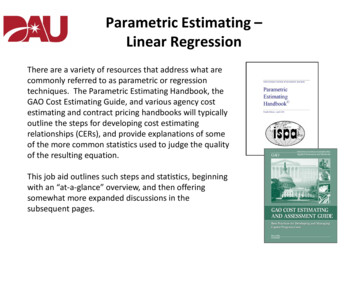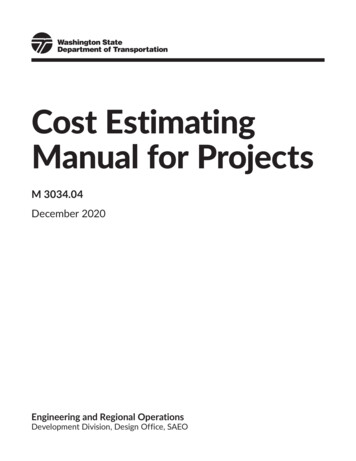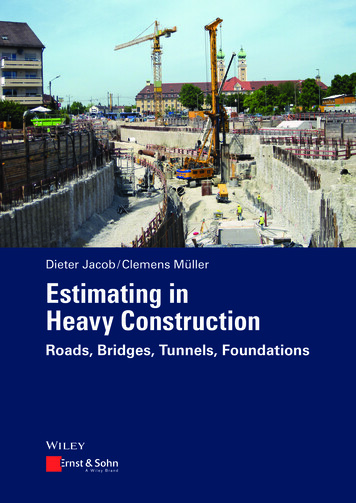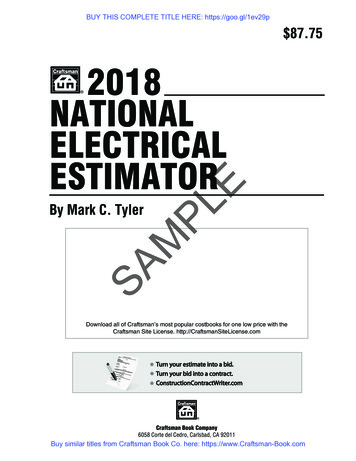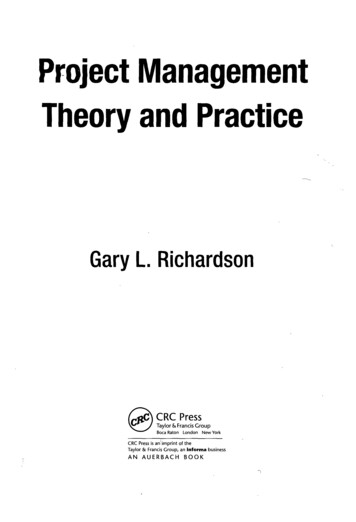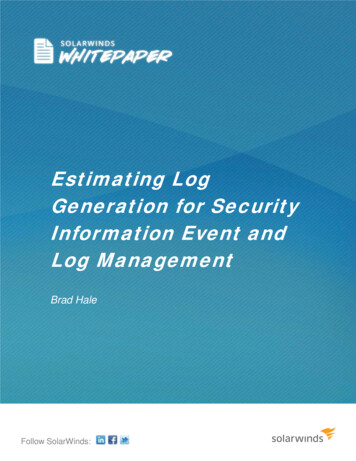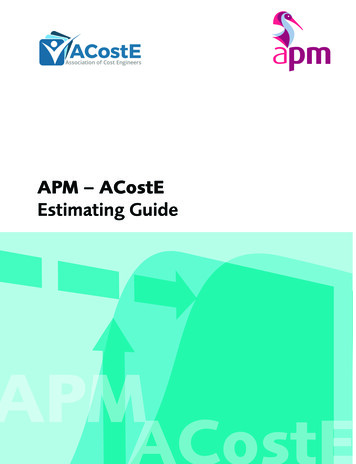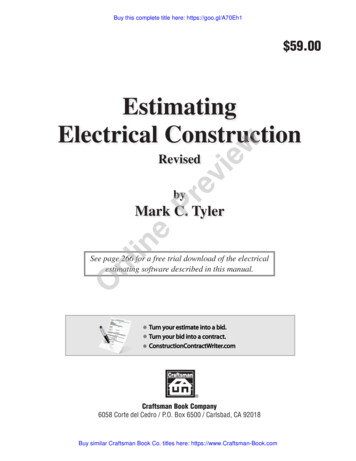
Transcription
Buy this complete title here: https://goo.gl/A70Eh1 59.00eviewEstimatingElectrical ConstructionRevisedPrbyineMark C. TylerOnlSee page 266 for a free trial download of the electricalestimating software described in this manual.Turn your estimate into a bid.Turn your bid into a contract.ConstructionContractWriter.com Craftsman Book Company6058 Corte del Cedro / P.O. Box 6500 / Carlsbad, CA 92018Buy similar Craftsman Book Co. titles here: https://www.Craftsman-Book.com
Buy this complete title here: https://goo.gl/A70Eh1AcknowledgementsThe author wishes to express his appreciation to the following companies and organizations forfurnishing materials used in the preparation of various portions of this book:eviewAmerican Arbitration Association — 1633 Broadway, 10th Floor, New York, NY 10019Appleton Electric Company — 9377 W. Higgins Road, Rosemont, IL 60018Calculated Industries, Inc. — 4840 Hytech Drive, Carson City, NV 89706Hubbell Lighting, Inc. (Formerly Marvin Electric Manufacturing Company) — 584 DerbyMilford Road, Orange, CT 06477Leviton Manufacturing Company, Inc. — 201 North Service Road, Melville, NY 11747Lithonia Lighting — P.O. Box A, Conyers, GA 30012Square D Company — 1415 South Roselle Road, Palatine, IL 60067Trade Service Publications, Inc. — 15092 Avenue of Science, San Diego, CA 92128Westinghouse Electric Corporation — 1000 Westinghouse Drive, Cranberry Township, PA 16066PrThis book is dedicated to all retired, active and student estimators.ineLooking for other construction reference manuals?OnlCraftsman has the books to fill your needs. Call toll-free 1-800-829-8123or write to Craftsman Book Company, P.O. Box 6500, Carlsbad, CA 92018 fora FREE CATALOG of over 100 books, including how-to manuals,annual cost books, and estimating software.Visit our Website: http://www.craftsman-book.comLibrary of Congress Cataloging-in-Publication DataTyler, Mark C.Estimating electrical construction, revised / by Mark C. Tyler.p. cm.Rev. ed. of: Estimating electrical construction / by Edward J. Tyler. 1983.Includes index.ISBN 978-1-57218-253-01. Electrical engineering--Estimates. I. Tyler, Edward J. Estimating electricalconstruction. II. Title.TK435.T93 2011621.319'24--dc222011005598 2011 Craftsman Book CompanyEdited by Brian E. P. Beeston and Michelle StrilerTemplate Devona Quindoy, dqartdesigns.comLayout by Devona Quindoy & Joan HamiltonBuy similar Craftsman Book Co. titles here: https://www.Craftsman-Book.com
Buy this complete title here: https://goo.gl/A70Eh11What Does It Take to Bean Electrical Estimator?. 5The.Design.Team. 7The.Construction.Team. 86Transfer.the.Takeoff.Data. 77Calculate.Each.Item’s.Cost. 78Material.Cost.Sources. 81The.Estimate. 11Finding Work& Submitting Bids. 13ine2Accurate.or.“Best”.Pricing. 847Choosing.the.Right.Projects. 15Labor.Costs. 93nlTypes.of.Bids. 23Cost.of.Equipment. 98Bid.Form.and.Submission. 29OSubcontract.Costs. 99First Steps in Estimating. 31Completed.Costing.Sheets. 99Takeoff.Items. 33Factors.That.Increase.Labor.Costs. 101Takeoff.Tools.and.Worksheets. 374The Job Walk& Pre-Bid Conference. 45Factors.That.Decrease.Labor.Costs. 107Other.Job.Variables. 1108Job.Phases. 46Takeoff Worksheetswith a Computer. 113Site.Conditions. 46The.Sample.Project. 113Pre-Bid.Conference. 50Starting.the.Takeoff. 119Site.Plans. 455Completing Your EstimateManually (Labor, Equipment& Subcontractor Costs). 93Bid.Documents. 173The Material CostEstimate. 77PrKey.Elements.of.a.Bid. 10eviewContentsAccurate Material Takeoff. . 539Detailed.Takeoff. 54Figuring Costs withthe National ElectricalEstimator. . 145The.Takeoff.Procedure. 57Estimating.with.National Estimator . 146Shortcut.Estimating. 53Buy similar Craftsman Book Co. titles here: https://www.Craftsman-Book.com
Buy this complete title here: https://goo.gl/A70Eh110 Overhead & Profit. 157 15 Smart Bidding. 215Adding Overhead and Profit .to Your Estimate. 157Calculating Overhead. 162Calculating Your Company’s .Optimum Profit Percentage. 165Adjustment for Risk. 215Asset Utilization Adjustments. 223Project Adjustments. 23111 Other Costs to Consider. 173 16 Pricing Strategies& Selling Your Bid. . 235Permits and Fees. 177Market-Based Pricing. 235Bid Bonds. 178Performance Bonds. 179Insurance Coverage. 180Progress Payments. 18012 Completing Your EstimatesLearn About Your Competition. 236Selling Your Bid. 241Scheduling. 245PrRetention. 181eviewContingency. 173& Bids Manually. 183ineFinalizing Your Estimate and Bid. 18317 Change Orders. 247Why Changes Are Made. 249Get It (and Give It) in Writing. 249Adding Rates for Additional Costs. 184Review Meetings. 253Finalizing Your Bid Summary Sheet 188Processing a Change Order. 254nl13 Completing Your EstimatesEffects of Change Orders. 256O & Bids Electronicallyusing National Estimator .& Job Cost Wizard. 191Modifying Costs. 191Printing and Saving Your Estimate. 197Preparing Your Bid. 19814 Cost Recording. 203Why Keep Cost Records?. 204Essentials of an Effective.Cost-Keeping System. 20518 Claims & Disputes. 259Subcontractor Claims. 259Preparing a Claim. 260Backcharges. 262Project Delays. 264Estimating Software & BlankForms Download. . 266Classifying Labor Costs. 208Using Cost Data. 212Index. 267Buy similar Craftsman Book Co. titles here: https://www.Craftsman-Book.com
Buy this complete title here: https://goo.gl/A70Eh1Chapter 1eviewWhat Does It Take to Bean Electrical Estimator?PrEOnlineLECTRICAL CONTRACTING IS A relativelynew business. Masonry, plumbing, framing,roofing and most construction trades can tracetheir roots back hundreds or even thousands ofyears. There weren’t any electricians or electrical contractors 150 years ago. The electrificationof America didn’t begin until the 1880s whenthe first commercial power-generating stationwas built in New York City.In the early days of electrical contracting,there was no electrical code. Installation practice was poor by today’s standards. In one groupof 65 mills where electric power was installed inthe 1890s, there were 23 serious fires — in thefirst six months! Still, the demand for electricityincreased rapidly. During the 1890s, trade associations, insurers and manufacturers developedstandards that became the National ElectricalCode , first published in 1897.NEC is revised every three years to betTheter protect people and property. Revisions aredetermined after studies by code committeesand have resulted in better electrical materials,more advanced designs and improved installation procedures. Constant code changes makethe work of electrical contractors and electricalestimators more difficult. But they also makefor better, safer, and more durable electricalinstallations.As the electrical contracting business developed and matured, the role of professionalelectrical estimators became more specialized.Anyone can quote prices for electrical work.Most states require that both electricians andelectrical contractors be licensed; but electricalestimators need no license at all. Under the law,company owners, managers, engineers, supervisors, electricians and salespeople can quoteprices for electrical work. Technicians fromtelephone companies, alarm system manufacturers, and electrical equipment manufacturersoften quote installation prices for their specialized electrical work.But please don’t misunderstand. Estimatingthe cost of electrical work can be a very detailed,exacting discipline. It takes specialized skillsand knowledge to create reliable estimates forelectrical work. That’s why electrical estimatingis so important to the success of any electricalcontracting company. Most work is awardedBuy similar Craftsman Book Co. titles here: https://www.Craftsman-Book.com
Buy this complete title here: https://goo.gl/A70Eh1Estimating Electrical ConstructionThe Electrical EstimatorSome electrical estimators begin a careeron the staff of a larger electrical contractingcompany. A typical estimating department in alarge electrical contracting firm will have oneor two junior or trainee estimators along withseveral more experienced estimators. When anelectrical estimator has developed the skills andcontacts necessary to be successful, many beginconsulting, or even start electrical contractingcompanies of their own. Some of the busiest andmost successful electrical estimators I know arefreelancers. Both the rewards and the risks aregreater when working for yourself. But clearlythere are advantages to working at your ownpace and setting your own hours.nlinePrAt one time, most electrical estimators werealso electricians, usually with at least six to eightyears of experience in the field. Experiencedelectricians tend to be good at reading drawings.They understand contract specifications andare proficient at following the NEC — essentialskills for every electrical estimator. Years ago,master electricians commonly drafted electrical layouts, showing receptacles, switches andfixtures. These drawings became supplementsto the architectural drawings and were used byinstallers to lay out the work. Material takeoffsand cost estimates were created from electricaldrawings prepared by a master electrician. That’sstill true today on small, service-type projects.sized electrical contracting company. Withadditional experience and training, it’s commonto transition to more complex, more technicalprojects.eviewthrough competitive bidding. The lowest qualified bidder usually gets the job. Profit marginscan be thin, especially when work is scarce. Thepenalty for a haphazard estimate can be a majorloss, and no electrical contracting companyneeds more of those. Nearly every electricalcontracting company needs the best effort of atleast one qualified electrical estimator.OBut work on larger projects is much morespecialized today. Electrical estimators seldomdraft electrical drawings and almost neverspecify materials or equipment. Those tasksare typically done by trained specialists, usuallyelectrical engineers or Computer-Aided Designand Drafting (CADD) professionals. Many largerprojects are “design-build” jobs, where the contractor is responsible for both the design andconstruction. There’s no competitive bidding,but estimates are still required. On design-buildprojects, the electrical estimator operates as amember of the design team, developing ROM(rough order of magnitude) prices for budgetpurposes.The electrical estimators I know come fromvaried backgrounds. Most worked as installersbefore taking a desk job as a service estimatoror residential estimator for a small- to medium An electrical estimator’s primary task isto develop a reliable estimate of job costs. Inpractice, it seldom stops there. Experiencedelectrical estimators often play a major advisoryrole, recommending preferred installation details,identifying risks and opportunities in the job,and maximizing value while minimizing costs. Agood electrical estimator can make a significantcontribution to any electrical construction team.On very large projects, there will often be achief estimator and several junior estimators. Inone of our practice examples, you’ll figure the costof work planned by the electrical design group.When done, you’ll hand the estimate over to thesenior estimator who will combine all estimatesto calculate the project cost. That total goes tocompany managers who will set a percentage formarkup, turning the estimate into a bid.Electrical estimating can be either full- or parttime work. Most smaller electrical contractingcompanies don’t bid enough jobs to keep anelectrical estimator busy full-time. The companyowner may be the only qualified electricalestimator available. Some smaller electrical contractors don’t even have an estimator on staff.Instead, they call on a freelance estimator whenthe need arises.Buy similar Craftsman Book Co. titles here: https://www.Craftsman-Book.com
Buy this complete title here: https://goo.gl/A70Eh1What Does It Take to Be an Electrical Estimator?The structural engineer (SE) designs theskeleton of the project, the foundation, andsupporting members. The SE plans equipmentbases, suspended members, seismic and windresistance and other structural components.The mechanical engineer (ME) designs theHeating, Ventilating and Air Conditioning(HVAC) system, plumbing and drainage.PrThe best electrical estimators have an instinctfor finding jobs with better-than-average profitpotential — and identifying jobs with more riskthan potential reward. That’s why a skilledelectrical estimator is a valuable asset to anyelectrical contracting company — possibly themost valuable member of the team. Electricalestimators are the first line of defense againstfinancial loss.with plans and specifications. The architect prepares the construction documents. These includean advertisement for bids, instructions to bidders, the contract, general and special conditionsto the contract, project specifications, projectdrawings, and guidelines for administration ofthe contract. On larger projects, the architecturalfirm will usually retain consulting engineers toadvise on technical phases of the project. Thesecan include a structural engineer, a mechanicalengineer and an electrical engineer.eviewMany electrical contracting firms, both largeand small, put the electrical estimator to workas project manager when a bid is accepted.After winning the job, the electrical estimatorputs on a hard hat and manages the project.That creates a tight feedback loop, making theproject manager a better estimator (more awareof costs) and the estimator a better projectmanager (more aware of installation issues).nlineNo matter where you fit in the picture, Ihope you’ve decided to build the qualificationsrequired to create a successful career in electrical estimating. Opportunities are plentiful.This manual is designed as a stepping stonealong your career path.OThe Design TeamConstruction is far more complex todaythan in 1890 when buildings were first wiredfor electrical service. Today it takes a team ofprofessionals to complete nearly any commercialor industrial building.Every job starts with a property owner. Theproperty owner sets the job in motion and paysthe bills, frequently from loan proceeds madeavailable by a commercial lender. The propertyowner isn’t usually a member of the design team,but selects at least the leader of that team, thearchitect.The architect plans a project that meets theneeds of the property owner. The architect mayalso act as the property owner’s representative,supervising construction to ensure complianceRewardsfor Electrical EstimatorsElectricians are among the highest paid constructiontradesmen, and electrical estimators are among the bestpaid estimators in the construction industry. Most largerelectrical contracting companies offer novice estimatorsa fair beginning salary with periodic increases. Somebase an estimator’s salary on a percentage of the ratepaid to journeymen electricians. The percentage is lowin the beginning but can be counted on to increase withexperience and competence. Most electrical estimatorswork on salary, get paid either weekly or bimonthly,and receive good benefits. Advancement opportunitiesare excellent for progressive electrical estimators. Asthe planner of new work, you can make an importantcontribution to the success of your company.Working conditions tend to be good. But timeis a major limitation for most electrical estimators.Accuracy (quality) is important, of course. But so isquantity. The more jobs you bid, the more contractsyou’re likely to win. Bid dates are set by the owner orthe prime (general) contractor. You have little or nocontrol over timing. The clock can become an electricalestimator’s worst enemy. Most bids are due on aparticular day at a specific time. A heavy workload canrequire putting in extra hours at the office — a smallsacrifice for a successful bid.Buy similar Craftsman Book Co. titles here: https://www.Craftsman-Book.com
Buy this complete title here: https://goo.gl/A70Eh1Estimating Electrical ConstructionThe electrical engineer (EE) designs theelectrical system: power generation (eitherthe primary or standby), primary and back-uplighting, a communications system (telephoneand voice mail), the computer network, a pagingsystem, a sound system, an employee-recognitionsecurity system, an intrusion system, and a firealarm system. The electrical engineer mustwork closely with the architect, the structuralengineer and the mechanical engineer. Electricalestimators have to estimate quantities andcosts for nearly anything an EE can design.subcontractor can’t or won’t finish the work,the bonding company hires another companyto complete the job — and then tries to recoveragainst the defaulting contractor.The design team’s work isn’t done until construction is complete. The design team may beresponsible for on-site inspections as the projectprogresses. The architect’s contract with a consulting engineer usually requires inspections toensure that installation complies with the plansand specifications. Consultants check the shopdrawings (submittals) prepared by manufacturers and subcontractors to be sure the finishedproduct will meet the property owner’s andarchitect’s expectations.On most jobs, there will be a prime contractor (the prime) and subcontractors (the subs).Sometimes there will be subs to the subs. A sub’sresponsibilities are very similar to those of theprime — just on a smaller scale. An electrical subsubmits a bid to do electrical work described inthe plans and specs. But that’s not all. Subs haveto meet all requirements of the contract, including bonds, insurance, licenses and taxes.inePreviewThe contractor must also provide insurancecoverage for casualty losses and other hazards.Most electrical contractors also take out thebuilding permit for the electrical portion ofthe job. Chapter 11, Other Costs to Consider,has more information on bonds, insurance,licenses and taxes.nlThe Construction TeamOA prime contractor has a contract with theproperty owner and leads the construction team,usually with the help of a few subcontractors.The prime contractor receives direction fromthe design team (plans and specs), instructionfrom the property owner (the contract) and rulesfrom the building codes (including the NEC).The bid documents usually require thecontractor to supply a bid bond. If the contractor’s bid is selected, the bid bond “binds” thecontractor to sign the construction contract atthe bid price. Most invitations to bid also requirethat the contractor supply a performance bondguaranteeing that work will be completed asshown in the plans. Bid bonds and performancebonds are underwritten by licensed bondingcompanies and are purchased at the expenseof the contractor or subcontractor whoseperformance is guaranteed. If the contractor or The prime contractor is responsible for thework of first-tier subcontractors as though thework was being done by the prime contractor’sown crews. Second-tier subs are responsible forthe work of third-tier subs, and so on.On a large job that lasts many months, theproperty owner will usually make progresspayments once or twice a month, creating acascade of payments that go from prime tofirst-tier to second-tier, etc. If a contract doesn’tallow for progress payments, the prime andsubs may have to take out loans to finance theproject. Interest on such a loan would thenbecome another cost on your estimate form.We’ll discuss progress payments in more detailin Chapter 11.Subcontractors usually have little or nodirect contact with either the architect or theproperty owner. They deal with the contractorone tier above and, of course, the inspector.On small jobs, like renovating the electricalsystem of an existing building, the electricalcontractor may be the prime contractor, workingdirectly with the property owner. Again, one orBuy similar Craftsman Book Co. titles here: https://www.Craftsman-Book.com
Buy this complete title here: https://goo.gl/A70Eh1What Does It Take to Be an Electrical Estimator?more subs may be called on to do specialty work.The entire construction team may consist of theproperty owner, the contractor, the estimator,the foreman, and an office manager who checksthe estimates and keeps the company books. Estimating the cost of the job Submitting a bid to the propertyowner (if the electrical contractoris the prime), or to the prime (if theelectrical contractor is a sub) Selling the bid — jobs don’tusually just fall into your lap Signing a contract if the bid isselected Planning the work (much of thishappens in the estimating phase) Doing the work — following theplans, specs, contract and code Getting the work signed off — andadding another satisfied customerto your listMost property owners don’t have the time or thebackground to manage a complex constructionproject. It’s usually easier, faster, and cheaper toassign the project to a dependable, experiencedbuilder. In that case, the owner may prefer tohave the builder take full charge of both projectdesign and construction (design-build).PrFinding a job that matchescompany capabilitiesOnline Some very large companies have their ownconstruction division. If that’s the case, the property owner may wear all three hats — propertyowner, designer and contractor. A builder who isalso the property owner will usually administerthe contract and set the construction schedule.eviewWhether an electrical contractor is the primeor the sub, the duties will be similar:alternatives that can save money or add valueto the building. The company I currently workfor is a design-build firm. We do it all, using ourown staff.Changes inElectrical ContractingTraditionally, construction projects havethree primary players: the property owner, thedesigner (architect and engineer) and the general contractor. But there are many variations.In a design-build job, the designer is also thebuilder (the general contractor). Most statespermit a builder to do design work for a projectconstructed by that builder, though the samebuilder-architect couldn’t do design work forconstruction by others. More often, the builderisn’t the designer — but still may be part of thedesign team, counseling on preferred materialsand installation methods and even suggestingYou’ll also hear construction professionalstalking about mechanical, electrical andplumbing (MEP) or mechanical, electrical,data and plumbing (MEDP) teams. Either way,it’s a team approach which combines designand estimating for the largest project subcomponents. Estimators, designers, detailersand engineers work together as a team to meetthe needs of the owner within a budget set bythe property owner.LEED certification is another topic you’llhear more about in the future. The U.S. GreenBuilding Council has adopted a certificationprogram called the Leadership in Energy andEnvironmental Design (LEED) standard. Thereare four levels of certification: certified, silver,gold, and platinum. The more energy efficientthe design, the higher the rating. Energyefficiency has an obvious advantage and a lessobvious disadvantage. Energy efficiency makessense in a world of high fuel costs. But energyefficiency also has its price. The more energyefficient a building, the higher the initial cost.That’s why LEED certification is good businessfor electrical estimators. Property owners wantto know, “Can we afford LEED certification?And if so, at what level?” Electrical estimatorshelp owners make good decisions about LEEDcertification.Buy similar Craftsman Book Co. titles here: https://www.Craftsman-Book.com
Buy this complete title here: https://goo.gl/A70Eh1Estimating Electrical ConstructionKey Elements of a BidYou bid a job to get the contract. Obviously,it’s wise to bid as low as possible. But bid toolow too often and your company will eventuallygo broke. A successful bid covers all costs: labor,materials, equipment, overhead (managers,office, taxes, insurance, etc.) and still has a littleleft over — your profit. Being the low bidderand getting the job isn’t always what you want.If you end up losing money on the job, you’dhave been better off losing the bid and lettingthe “winner” take the loss. A good bid is highenough to earn a profit but low enough to getthe work.PrThe estimating process begins with the plansand specs and ends with the presentation of thebid. Bidding electrical work can be a complexprocess and may involve many hours of detailedwork. Leave out any step and your bid can gofrom “first to worst.”Even on the contracts you win, you may haveto defend your work. One common criticism:“Why was our bid so much lower than the nextlowest bid? You left too much money on the table.We could have made thousands more.” So keepgood records. Be ready to defend your estimatesagainst someone else’s 20/20 hindsight.eviewAll electrical contractors, from the smallestresidential firm to the largest multi-statecompany, have an interest in avoiding waste ofelectrical resources. They support restrictionson the use of incandescent lamps, promotefluorescent alternatives, solar generation forhomes, commercial and industrial applications,better electrical management systems anddesigns for large commercial installations.OnlineYour job as an electrical estimator is tocalculate the cost of completing the electricalwork on a project. That’s your estimated cost,your cost to the contractor for doing the work.Bid price is the figure quoted to the primecontractor or the property owner — what theproperty owner has to pay. The differencebetween cost and price is profit. We’ll discussboth overhead and profit in detail in Chapter10, Overhead and Profit.A Successful BidWinning a contract for electrical workis seldom easy. In fact, an estimator who’ssuccessful 25 percent of the time is the happyexception to the rule. As an electrical estimator,assume you’ll have many more defeats thanvictories. No lawyer, doctor, or baseball playerwould get by with a construction estimator’ssuccess ratio. An electrical estimator who winsas few as 10 percent of the jobs he bids belongsin the estimating hall of fame. A doctor burieshis losses; a lawyer visits his in jail. You’re lucky:The worst outcome is simply rejection.10Finding the best bid price is a careful balancing act. Most competitors will have similarlabor, material and equipment costs. Overheadcosts can vary widely. Profit expectations alsovary from contractor to contractor. As anelectrical estimator, your primary concern willbe the hard costs (labor, material, equipment)and overhead. Company management willdecide how much to add for profit. In a smallfirm, the company owner will make decisionson profit margin. In a larger company, the headof the electrical contracting division may setthe profit margin.There may only be a few companies in thearea qualified to handle the job you’re bidding. Ifyou’re one of those companies, winning the jobmay be easy. But if there’s a lot of competitionfor the same job, bidding will be competitive.If all bids meet job requirements, the contractwill usually be awarded to the lowest bidder. Ifit’s a government or public contract, the lowestqualified bidder will always get the work. Butif it’s a private contract, anything can happen:The lowest bidder doesn’t automatically getthe job. We’ll deal more with this topic inChapter 15, Smart Bidding.Buy similar Craftsman Book Co. titles here: https://www.Craftsman-Book.com
Buy this complete title here: https://goo.gl/A70Eh1What Does It Take to Be an Electrical Estimator?Electrical estimating is more art thanscience. Electrical contractors know that mostof the profit or loss in a job comes from anestimator’s desk, not the construction site. By
Craftsman has the books to fill your needs. Call toll-free 1-800-829-8123 or write to Craftsman Book Company, P.O. Box 6500, Carlsbad, CA 92018 for . drawings prepared by a master electrician. That’s still true today on small, service-type projects. But work on larger projects is

